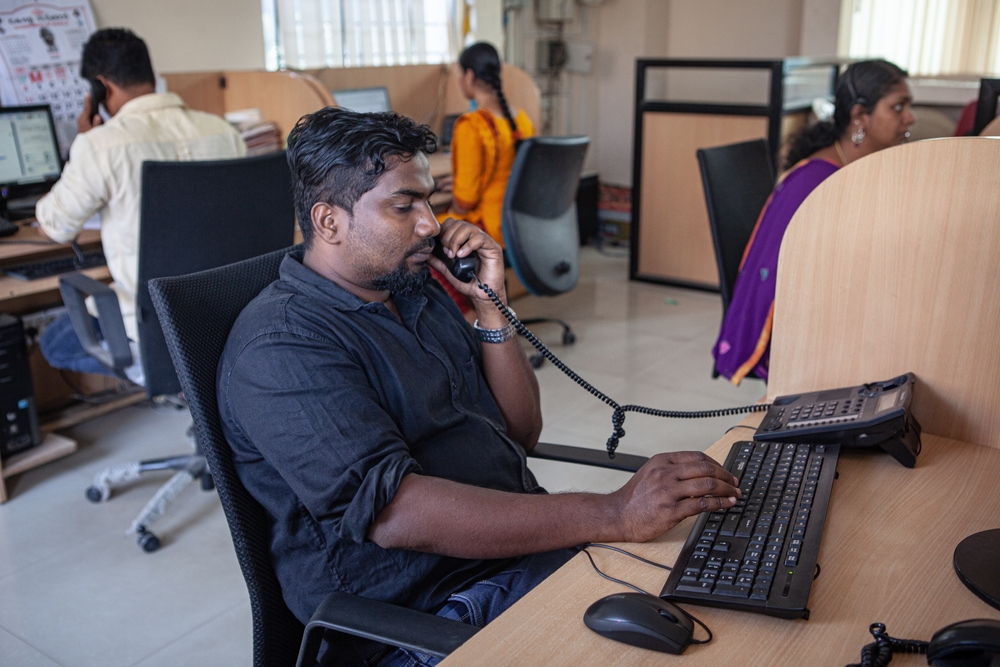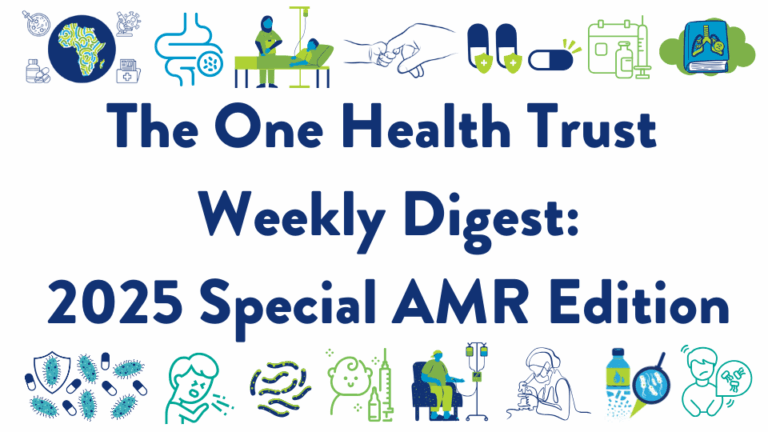October 30, 2023

A malaria vaccine with lasting efficacy can reduce the disease burden and combat drug resistance.
Antimalarial drug resistance threatens malaria treatment and control. OHT researchers used compartmental modeling to determine the potential of malaria vaccines with different efficacies in decreasing drug-resistant malaria infections. To predict the impact of a vaccine on Plasmodium falciparum infections in 42 African countries from 2021 to 2030, three vaccine efficacy (VE) scenarios were analyzed. Results showed that a consistent VE of 40 percent over 10 years could avert more cases, drug-resistant infections, and deaths than a vaccine with a high initial VE that drops quickly. A malaria vaccine with prolonged efficacy could significantly lessen Africa’s health burden and implications of drug resistance. [Nature Communications]
Humans likely play a larger role than fish in transmitting Streptococcus agalactiae, an emerging food pathogen.
Outbreaks of Streptococcus agalactiae (group B Streptococcus; GBS) sequence type (ST) 283 linked to fish consumption in Asia have drawn attention to GBS ST283 as an emerging foodborne pathogen capable of generating disease in the general population. To inform public health interventions, researchers, including OHT’s Dr. Thomas Van Boeckel, gathered 328 whole genome sequences collected from humans and fish between 1998 and 2021 across 11 countries spanning 4 continents. Applying Bayesian modeling to reconstruct the evolutionary history of ST283, host transitions, and geographic dispersal, they found expansion within Asia following emergence in the early 1980s, with subsequent intercontinental dispersal to the Americas over the last 20 years. The study identified frequent bidirectional human-fish host switching, with more human-to-fish than fish-to-human transitions, suggesting transmission cycles could be interrupted through improved sanitation and wastewater management. [PLOS Global Public Health]
Carbon monoxide pollution accounts for significant productivity losses in Indian call centers.
OHT researcher Dr.Deepshikha Batheja co-authored a study investigating the impact of three components of air pollution – carbon monoxide (CO), ozone (O3), and particulate matter of less than 2.5 micrometers (PM2.5) – on daily productivity in five call centers in India. Significant reductions in worker productivity, measured by the number of calls per shift, were observed with increasing levels of all three pollutants; one standard deviation increase in the concentration of PM2.5, CO, and O3 correlated to decreases in worker productivity of 11.8, 10.8, and 6.0 percent respectively. Notably, increases in CO levels were associated with significant reductions in worker productivity despite concentrations below WHO-recommended levels. The total loss of productivity could be predominantly attributed to CO, which accounted for 58 percent of the loss, while PM2.5 and O3 each accounted for 21 percent. Call centers serve as major private sector employers in India and drivers of the national economy, highlighting the need for policies targeting pollution-driven reductions in employee productivity and well-being. [Center for Effective Global Action]
Girls in India are enrolled in private preschools at lower rates than boys.
OHT researcher, Dr. Arindam Nandi, and co-authors examined gender gaps in preschool enrollment among children aged two to four years in India. Using data from the National Family Health Survey of India 2019-2021, researchers found that girls had a 3.8 percent higher preschool enrollment rate than boys but were 10.7 percent less likely to be enrolled in a private preschool. Girls with mothers with no schooling attainment, from Hindu families, and living in urban areas were less likely to be enrolled in private preschools compared to boys, indicating the multifactorial impact of children’s socioeconomic background on private preschool selection. After controlling for shared households, regression analysis revealed that within the same household, girls were 16.7 percent less likely to be enrolled in a private preschool than boys. While the country has made significant progress in eliminating familial preference for sons over daughters, India’s pervasive gender discrimination is evident in the lower rates of private preschool enrollment among girls seen in this study. [International Journal of Educational Development]
World Health Organization Taskforce of Antimicrobial Resistance Survivors
The WHO announced the first Taskforce of Antimicrobial Resistance Survivors, comprising individuals who have cared for people with severe drug-resistant infections (DRIs) or survived DRIs themselves. The mission of this important Taskforce is to help shape the global AMR narrative, advocate for policies targeting drug resistance, and bring visibility to the “human” aspect of the AMR crisis. Members of the Taskforce represent the United States, the United Kingdom, India, South Africa, Zimbabwe, Nigeria, Kenya, Lebanon, and Indonesia. [WHO]
The effects of vaccine mandates and accessibility on individual vaccine attitudes and coverage.
Mathematical models exploring the effects of individual vaccine hesitancy, vaccine mandates, and accessibility on the population dynamics of vaccine hesitancy and related behaviors show that the presence of a vaccine mandate will make a vaccine-hesitant parent more likely to vaccinate their offspring, while vaccine inaccessibility will make a vaccine-confident parent less likely to do so. In a mostly vaccine-hesitant community, vaccination coverage was higher when a less strict mandate was implemented compared to a complete absence of a mandate, but the leniency of such a mandate opens up the possibility of obtaining a vaccine exemption. This indicates that external pressure from a mandate can counter a culture’s vaccine hesitancy but would need to be strict to help achieve herd immunity in a highly hesitant population. Furthermore, vaccine inaccessibility in a predominantly vaccine-confident community would decrease coverage. Future policies must consider the interplay between individual beliefs, cultural attitudes, and physical access and availability of vaccines to effectively increase vaccine coverage rates. [PLOS Global Public Health]
Flood severity and prior drought conditions are associated with diarrhea prevalence in children.
A cross-sectional study of 639,250 children under 5 years old in 43 LMICs assessed the association between flood exposure and the risk of diarrhea and evaluated the influence of water, sanitation, and hygiene (WASH) on this association. Using data from national Demographic and Health Surveys collected between 2009 and 2019, the study found that the prevalence of diarrhea among children in the 8 weeks following a flooding event was 13.2 percent (n=839) among those exposed to flooding and 12.7 percent (n=80,337) among those unexposed. After stratifying floods by severity and duration, significant associations were observed for floods lasting more than 2 weeks (odds ratio at lag 4 weeks: 1.47, 95% CI: 1.13-1.92) and for extreme floods (OR at lag 5 weeks: 2.07, 95% CI: 1.37-3.11). Less severe and shorter-duration floods were not significantly associated with diarrhea risk. Significantly higher ORs were observed for children living in households with no water available for handwashing (OR at lag 3-4 weeks: 1.80, 95% CI: 1.34-2.41). Prior drought conditions were also found to compound the positive association between diarrhea risk and flooding events. [JAMA Pediatrics]
Stakeholders in Kenya point to external limiting factors on infection prevention in slaughterhouses.
Researchers held six discussions with key stakeholders in three counties in western Kenya to understand the challenges and efforts related to reducing antimicrobial resistance (AMR) in slaughterhouses. Participants identified limited human resources and inadequate funding as key challenges, resulting in insufficient equipment and infrastructure to manage bacterial AMR. Lack of surveillance of AMR pathogens in slaughterhouses was also found to be a barrier to dealing with AMR. Most slaughterhouse workers were aware that their frequent contact with animals in the workplace increased their risk of infection with drug-resistant pathogens, but financial limitations were a barrier to taking measures such as handwashing and the use of protective equipment to prevent transmission. [Emerging Infectious Diseases]
WHO approved a new malaria vaccine.
In line with advice from the WHO: Strategic Advisory Group of Experts of Immunization, the WHO announced in late September 2023 their recommendation of the R21/Matrix-M vaccine to prevent malaria in children. Together with the previous RTS, S/AS01 malaria vaccine approved in 2021, this new vaccine will improve vaccine availability and coverage among children in malaria-endemic regions. When administered before the high transmission season, the R21 vaccine was shown to reduce symptomatic malaria cases by 75 percent for one year following a three-dose series. At US$2 and US$4 per dose, the cost-effectiveness of the R21 vaccine is comparable to that of existing malaria interventions. The next steps for the R21 vaccine include WHO prequalification, which ensures high-quality manufacturing before international distribution. [WHO]
Fresh produce contributes to the transmission of drug resistance.
A study of 75 imported and 75 non-imported fresh produce samples purchased from Swiss retailers identified 91 antimicrobial-resistant bacteria (ARBs) and at least one antimicrobial-resistant gene (ARG) in 95 percent of samples. These bacteria and genes were linked to resistance to cephalosporins and carbapenems, multi-drug resistance, and resistance to antiseptics and disinfectants commonly used in food production. There was no difference in ARB and ARG abundance between local and imported produce. Fecal and anthropogenic contamination were identified as significant sources of ARBs and ARGs in fresh produce. [Science of the Total Environment]
Knowledge, attitudes, practices, and beliefs contribute to malaria persistence in parts of Tanzania.
Malaria is a major public health threat in Tanzania, where it is the leading cause of morbidity and mortality, especially in pregnant women and children under five. Despite risk reductions in many other countries, 93 percent of the Tanzanian population is still at risk for malaria transmission. An exploratory study into the knowledge, attitudes, practices, and beliefs regarding malaria transmission revealed that some people did not know the cause of malaria, had misconceptions about the safety and efficacy of treated bed nets and indoor residual spraying, utilized traditional healers and herbal remedies, and avoided health centers due to shortages of qualified healthcare workers. Poverty, increased mosquito breeding sites in poor neighborhoods, and insufficient healthcare financing were also identified as contributors to malaria persistence in the area. [Malaria Journal]
Image from Shutterstock











